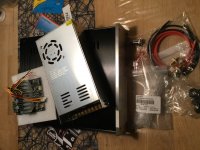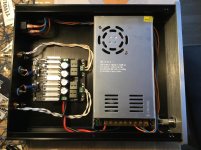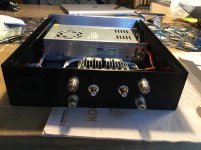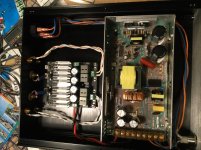Hi Graham,
I have seen it before but not had one to test. I am a low power guy (says my wife). It may be able to go further down in loading without noise.
Thanks, man. Its interesting because it is very small and passively cooled. It could go in a 1u rack case for sure.
Sorry to thread hijack but this has some interesting info on it....
I am looking at the 3e audio tpa3251 4x 100wpc. What power supply would you reccomend and what would the effect if underpowering with a lower wattage psu be other than reduced output?
This psu looks good:
£38.78 | 400W 24V/15.5A 12V/2A Mini Digital Power Amplifier Switching Power Supply With PFC For Amplifier
AliExpress
Most interesting will be to hear how it compares to my rather old Rotel class AB amplifier (2x80W), especially with vinyl!
It will definetly have enough power, that's for sure!
Anyone have any idea what to expect?
I've never used a class d on my main system so await your impressions!
Thanks, man. Its interesting because it is very small and passively cooled. It could go in a 1u rack case for sure.
Sorry to thread hijack but this has some interesting info on it....
I am looking at the 3e audio tpa3251 4x 100wpc. What power supply would you reccomend and what would the effect if underpowering with a lower wattage psu be other than reduced output?
This psu looks good:
£38.78 | 400W 24V/15.5A 12V/2A Mini Digital Power Amplifier Switching Power Supply With PFC For Amplifier
AliExpress
24V supply will allow 70W in 4 Ohm or 35W in 8 Ohm. With 4 Ohm speakers, the power supply is fine and with good margin. With 8 Ohm speakers, the power supply is "overkill".
The TPA3251 chip can operate down to 12V so 24V is fine for the chip. The 3E-board is recommended to operate with a supply voltage in the range 24-32V, thus 24V should be fine. Only the output power should change (reduce) with less supply voltage, not the SQ. SQ with Class D amplifiers is less supply voltage dependent than for class AB. A clear advantage with less supply voltage is that the heatsink becomes less warm.
You must be aware that you loose headroom, if you use less voltage than optimal for any amp. This might compress the sound even at moderate levels, if the music has high dynamics.
Even very small high quality speaker, today can take very high bursts, which makes them sound so amazing. I write "high quality", because we are in a DIYS forum and many build their speakers, too. So if you have a pair of small Scan Speak, Seas or Peerless etc. based speakers, you might be right to use a high power amp on it.
I never found any disadvantage by using amps that are 5 times stronger than the speakers are rated.
This question is asked very often, because people want to use something as a power supply, that is already in their possession. So, yes, you can use a mismatched power supply, if it has less volt than possible with the amp, but do not expect the optimum result. For a first test, this maybe OK, but if you are disappointed, don´t blame the amp module.
Even very small high quality speaker, today can take very high bursts, which makes them sound so amazing. I write "high quality", because we are in a DIYS forum and many build their speakers, too. So if you have a pair of small Scan Speak, Seas or Peerless etc. based speakers, you might be right to use a high power amp on it.
I never found any disadvantage by using amps that are 5 times stronger than the speakers are rated.
This question is asked very often, because people want to use something as a power supply, that is already in their possession. So, yes, you can use a mismatched power supply, if it has less volt than possible with the amp, but do not expect the optimum result. For a first test, this maybe OK, but if you are disappointed, don´t blame the amp module.
Interesting, thanks for the reply. I suppose what I don't understand is what wattage the PSU needs to be in order for the TPA3252/TPA3255 to function and best capacity. What is most presumably obvious is that it needs to have more watts than the amp power output?
For instance, Kjaerlarsen has picked a wattage higher than the amp output. Is this because the amp is not 100% efficient?
For instance, Kjaerlarsen has picked a wattage higher than the amp output. Is this because the amp is not 100% efficient?
Interesting, thanks for the reply. I suppose what I don't understand is what wattage the PSU needs to be in order for the TPA3252/TPA3255 to function and best capacity. What is most presumably obvious is that it needs to have more watts than the amp power output?
For instance, Kjaerlarsen has picked a wattage higher than the amp output. Is this because the amp is not 100% efficient?
I guess I did it due to what we used to do in the past with class-AB amplifiers and traditional power supplies, the bigger the supply, the better.
I chose the size of the power supply based on the maximum power the amp can deliver in 4 ohms, it may be overkill, but the price difference was very small. Also, I chose voltage in the upper range of the amps working limits, which should ensure that no headroom is lost.
I do hope I got it right, only time will tell.
It is obviuous requiment for a bigger PSU wattage. You must also take out efficiency of the amp. And you don't want to force PSU to work on the maximum load for two reasons:Interesting, thanks for the reply. I suppose what I don't understand is what wattage the PSU needs to be in order for the TPA3252/TPA3255 to function and best capacity. What is most presumably obvious is that it needs to have more watts than the amp power output?
For instance, Kjaerlarsen has picked a wattage higher than the amp output. Is this because the amp is not 100% efficient?
1. Overload protection and there are 3 types. Some PSU's make smooth transition from voltage regulation to current limiting, this one is the best for you. The other one will temporary pause conversion and restore operation after removing a cause. You will definitely notice it when happens. The third type will permanently lock-up PSU output. You will have to complete power cycle to restore operation.
2. Working on the limits increase PSU noise, as rectifiers works harder there are bigger requirements for the size of capacitors in the output filter. In addition, the best PSU (see #1) has apparently the poorest noise parameters on the maximum load, so it is not a good idea to depend on the current limiting feature anyway.
Interesting, thanks for the reply. I suppose what I don't understand is what wattage the PSU needs to be in order for the TPA3252/TPA3255 to function and best capacity. What is most presumably obvious is that it needs to have more watts than the amp power output?
For instance, Kjaerlarsen has picked a wattage higher than the amp output. Is this because the amp is not 100% efficient?
For a class D amplifier you have a typical efficiency of 90%. That means, that per channel of the amplifier, you divide the maximum output power the amplifier may deliver in any actual load (2-8 Ohm) with 0.9 to come to the power needed from the power supply, per amplifier channel. Then you multiply with the number of channels, if they all operate the same load impedance, to arrive at the total power demand from the power supply.
What you sometimes see mentioned as the "crest factor of music" allows us to use a power supply with less power (down to half) than calculated above.
Using the calculation above and stepping up in size to the next standard power value of the power supply is safe play.
Last edited:
The type of power supply is indeed the cause for the different answers to this "simple" question, if you ask different people.
There are parts even with good DIYS, where you can not find the perfect single solution.
Example one: I want to use low cost stuff. I buy at Alibaba, eBay or Amazon.
The amp module has been used by others and found to be OK. The amp should put out it´s maximum power of 160 W for a small sub woofer for a home cinema. It may run with constant high load and distortion sometimes, which is no problem with very low frequency.
I buy a no name OEM supply, rated at 240W, to feed my 36V amp. This takes into account, that the Chinese producer of the PS is rating it very optimistic, the amps 90% efficiency and the possible lowest load a 4 ohm rated woofer may have. Seen from this perspective, 1/3 or 50% of of a reserve seems to give some peace of mind.
2. Example: I want a high quality amp for my Dad´s floor standers. It may cost a little more. He usually listens low volume, just sometimes likes an opera loud.
I take a good 2x 140 amp module from a reputable constructor/ seller, use the recommended power supply of 200 W and will be fine.
Even as I only have 2/3rd or 65% of the amps nominal output power, the PS will have enough reserve to play some peak´s that may be in the music sometimes.
Both amps do nothing wrong, one with 65% PS, the other with 150% theoretical power.
There are parts even with good DIYS, where you can not find the perfect single solution.
Example one: I want to use low cost stuff. I buy at Alibaba, eBay or Amazon.
The amp module has been used by others and found to be OK. The amp should put out it´s maximum power of 160 W for a small sub woofer for a home cinema. It may run with constant high load and distortion sometimes, which is no problem with very low frequency.
I buy a no name OEM supply, rated at 240W, to feed my 36V amp. This takes into account, that the Chinese producer of the PS is rating it very optimistic, the amps 90% efficiency and the possible lowest load a 4 ohm rated woofer may have. Seen from this perspective, 1/3 or 50% of of a reserve seems to give some peace of mind.
2. Example: I want a high quality amp for my Dad´s floor standers. It may cost a little more. He usually listens low volume, just sometimes likes an opera loud.
I take a good 2x 140 amp module from a reputable constructor/ seller, use the recommended power supply of 200 W and will be fine.
Even as I only have 2/3rd or 65% of the amps nominal output power, the PS will have enough reserve to play some peak´s that may be in the music sometimes.
Both amps do nothing wrong, one with 65% PS, the other with 150% theoretical power.
So, when building up this amplifier, is there any way to control it via some sort of signal?
My surround reciever has a 12V output for switching on and of external amplifier.
Some sort of relay (solid state?)? or is ther something useable on the circuit board itself?
Another thing is, what if I leave the amplifier on all the time, what will happen when the preamp switches on and off?
My surround reciever has a 12V output for switching on and of external amplifier.
Some sort of relay (solid state?)? or is ther something useable on the circuit board itself?
Another thing is, what if I leave the amplifier on all the time, what will happen when the preamp switches on and off?
Hi Kjær-Larsen,
TPA3255 is one of the best chips.
And it is designed to allow post filter feedback (PFFB)!
This the big difference with other chip.
Hi.
B so I guess more than 150W/8 Ohms would not be needed.
So then UcD180 from hypex is the best for this application.
Got to test the amp with a set of speakers in the basement. And everything works, and plenty of power. No noise at all, except for the cooling fan for the power supply. Quite noisy, even though stated that it is temperature controlled. So took the lid off.
Going to hook it up to my stereo tomorrow. Going to be interesting to hear the sound quality.
Going to hook it up to my stereo tomorrow. Going to be interesting to hear the sound quality.
Attachments
Got time to spend a few hours listening on my stereo.
First impressions are good. There’s absolutely no noise of any kind. Low end is deeeeep and very well controlled and tight! Midrange is okay, not quite as detailed as my Rotel amplifier, but not bad at all. High end lacks a little detail but quite neutral. Sound stage is not as wide and deep as I could wish for, but it does nothing wrong, just not quite up where I would have liked it to be.
But considering the building cost of around €200 it certainly performs well!
I’m considering building a new amplifier using the Hypex ucd180hg modules, I guess I will get the details and soundstage I’m looking for.
First impressions are good. There’s absolutely no noise of any kind. Low end is deeeeep and very well controlled and tight! Midrange is okay, not quite as detailed as my Rotel amplifier, but not bad at all. High end lacks a little detail but quite neutral. Sound stage is not as wide and deep as I could wish for, but it does nothing wrong, just not quite up where I would have liked it to be.
But considering the building cost of around €200 it certainly performs well!
I’m considering building a new amplifier using the Hypex ucd180hg modules, I guess I will get the details and soundstage I’m looking for.
Hello,
it joins my own appreciations.
This amplifier can be improved with the change of the OP (not try again), so I think that changing the SMD link capacitors, by better capacitors should bring what is missing as sound.
Thanks for the advice. Where are these SMD capacitors located? Is it the four sitting next to the coils?
Sounds like a manageable tweak.
- Status
- This old topic is closed. If you want to reopen this topic, contact a moderator using the "Report Post" button.
- Home
- Amplifiers
- Class D
- Amplifier DIY kit recomendations



